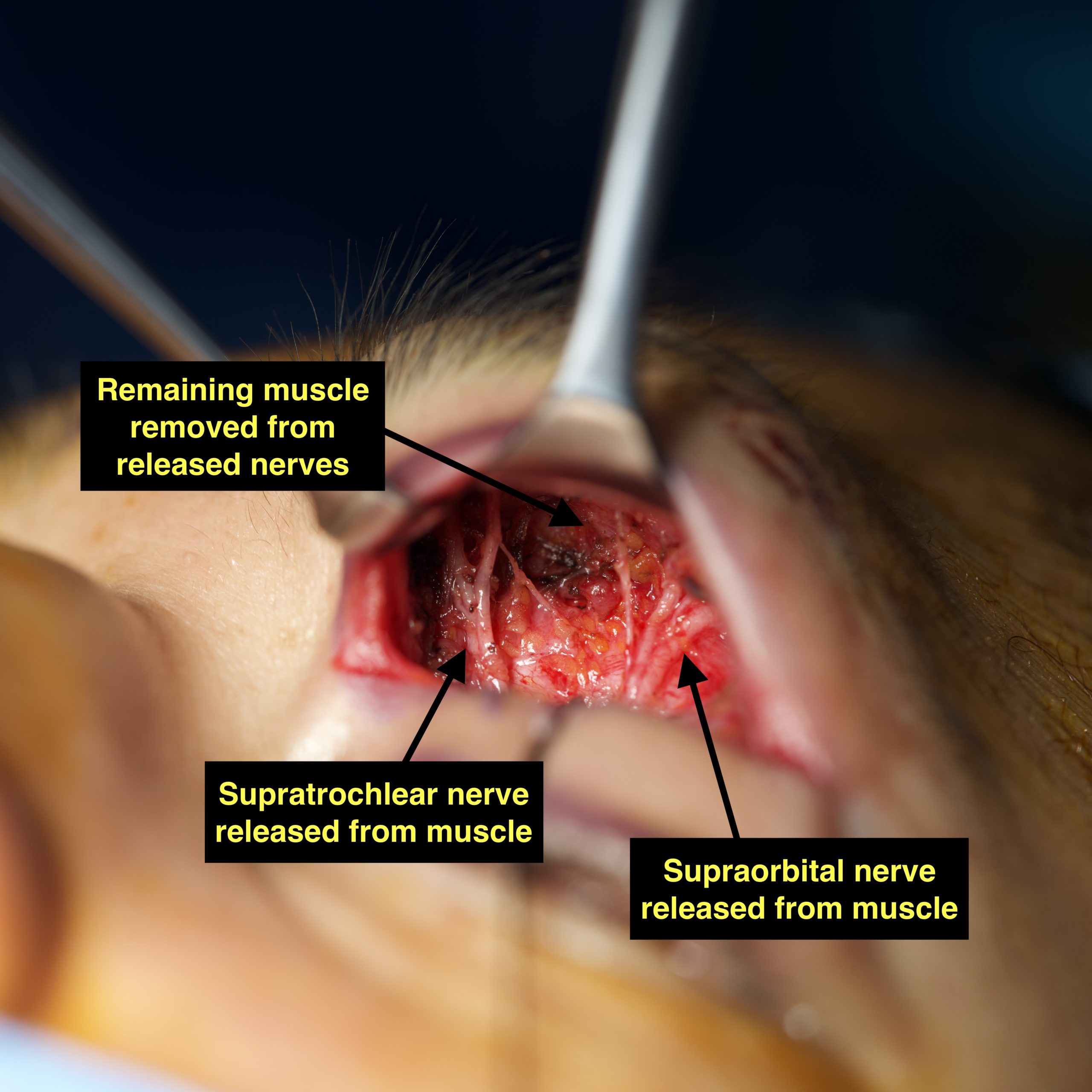
Supraorbital Nerve Decompression Migraine Surgery
Case 1
For those patients and others that are interested in seeing what migraine surgery actually looks like, here are some photos from one of my frontal migraine patients during her surgery. This woman had severe headaches with pain behind her eye and radiating up her forehead and temple. All photos are displayed with full consent from the patient.
The incision is made in the upper eyelid in the same way we would for a cosmetic eyelid operation. From there, the nerve is found coming around the upper orbital bone. Here it is often compressed by a band of tissue that can be seen here with the tips of the scissors behind the constricting band.

With a bit more dissection, the nerve bundle that is causing the patient’s pain can be found behind the constricting band of tissue. This compression and constriction causes the nerve to send distress signals to the brain which is manifested as migraine pain. Release of this constriction and compression from this band and the nearby muscle is the goal of the migraine surgery.

After the band of constricting tissue is released, the nerve can be seen heading toward the forehead where it crosses through some of the muscles of the brow before supplying the forehead with feeling and sensation. The next step is to release the nerve from any crossing blood vessels and the compression of the eyebrow muscles. Just as Botox relaxes this same muscle bundle and reduces compression on the nerve, surgical division of the muscle prevents nerve compression and the nerve no longer sends distress signals to the brain.

Here you can see the branches of the supraorbital nerve fully released from the surrounding constricting tissue. The muscle has been divided allowing for a relaxed course for all of the nerve branches. The nerve is no longer distressed by the surrounding compression, and therefore should no longer be causing migraine headache pain.
Case 2

This patient complained of chronic severe migraines in the forehead above her eyes, and had a great response to nerve blocks but not to Botox injections. During surgery, once the bone of the upper orbital rim behind the eyebrow was exposed, we see that her bone was compressing her nerves as they tunneled through a tight hole. Because Botox only works to relax muscles, Botox will not relieve pain in cases like this where it is bone instead of muscle that is compressing the supraorbital nerve.

This second photo shows how the nerve compression is relieved once the bone tunnel is released by removing a small amount of the bone of the upper orbital rim. The nerves are no longer compressed in the bony tunnel (also called a “foramen”) and so they will no longer send distress signals to the brain causing the migraine pain in the forehead. Decompression of the supraorbital nerve in this case provides headache relief.
Case 3

This 38-year-old professional suffered from headaches behind her eyes and in her temples and forehead since childhood. She had experienced some relief with aesthetic Botox in the past, which indicated to Dr. Lowenstein that the muscles of her brow were likely constricting her supraorbital and supratrochlear nerves, thereby causing her headaches. Botox causes temporary paralysis of muscle, and when injected in the brow to prevent frown lines, it allows for relaxation of the muscles that have been squeezing the nerves and causing the migraine headaches. Dr. Lowenstein performed diagnostic nerve blocks which provided excellent relief and clarified that she was a good surgical candidate. This intra-operative photo shows her nerves after they were freed from the muscle of her brow.
